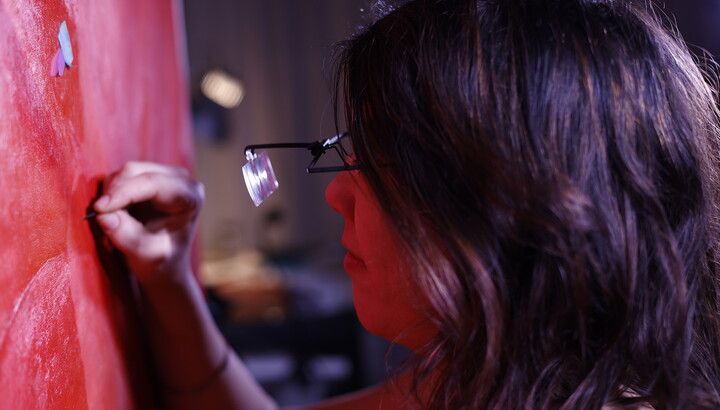The Carter Blog
Carter ARTicles
Using the Carter's Educator Resources
Aug 04, 2022
Art is complex. With so many periods, styles, artists, and materials, you can easily feel lost when standing in front of an unfamiliar artwork. What does it mean? Why did the artist create it? Why is it at the Museum? In some cases, you may stand there just trying to figure out what exactly you’re looking at, let alone how to explain it to an entire classroom of students! It can feel daunting to try to translate such complex information into digestible lessons for children. This is one of the jobs of museum educators—to guide visitors, especially students, through a meaningful encounter with art.
As much as we would love to provide in-person educational experiences to all students and teachers, we recognize that not everyone is able to schedule a guided tour. That’s where our Educator Resources come in. These are lesson plans based on the Carter’s collection that the Museum’s education team has developed over the years and that have proven successful with students.
These resources are available on the Carter’s Collection page. You can search for a specific artwork to see if an associated resource is available. Or you can select the “Has Educator Resource” filter to generate a search of all artworks with a lesson plan available.
Once you select an artwork, open the artwork’s page and scroll down to find the Educator Resources.
There are three types of resources: Essential Questions, Questioning Strategy, and Suggested Activities.
Essential Questions are the “big picture ideas” that are sparked by the artwork. Think of these as the learning objectives that students will address after closely examining the work. Whether you use the Questioning Strategy provided or tailor your approach to your curriculum, these questions can serve as guideposts on ways to engage students. A great example is the Educator Resources for Winslow Homer’s Blyth Sands. The Essential Questions invite students to assess the value of preparatory works, like this study, as artworks or simply identify the role of color in creating mood within an artwork.
The Questioning Strategy is the meat of the resource. The Carter’s teaching philosophy for student learning is an inquiry-based model that allows students to co-create their learning. At the Carter, we prioritize allowing students to take their lived experiences and background knowledge to inform their understanding of the artwork. Rather than provide a list of talking points, these lesson plans provide questions that direct students toward close-looking and critical thinking about what they see. These resources are formatted with questions that you can pose directly to your students as well as supplemental information about the artwork to help you guide student learning. Returning to Blyth Sands, to help students think through the value of studies, we ask “Why do you think Winslow Homer created this image? How might this type of work be used? Typically, studies were not created for public display; why do you think this study is now part of a museum collection and on display?”
What I love most about this section is how wide-ranging it is. Whether you’re a first grade Language Arts teacher or a high school U.S. History teacher, there’s something here for your classroom. With Blyth Sands, a language arts teacher may skip over the questions on preparatory works and instead focus on narrative. In that case, you could encourage students to infer the relationship between the figures in the drawing by asking questions like, “How did the artist use the placement of the figures to help us form an opinion and shape our understanding of the narrative?” If you’re in a social studies classroom, you might lean your questioning strategy toward representation and how that shapes historical memory. With Blyth Sands, we like to invite students to assess what the artist is trying to communicate about the community in Blyth, England. To ensure students across many grade levels are engaged, the questions have internal scaffolding, meaning we start with the easier entry points of what students see and then build into the abstract, big picture concepts behind the artwork. Wherever your students are in their learning, you can tailor the conversation to fit the needs of your classroom.
Finally, Suggested Activities bring a little fun into the classroom! There’s no need to be intimidated by this section, even if you’re not an art teacher. Some activities are arts skill focused while others lean into writing or research. If you’re uncertain what activity will work best for your classroom, recommended grade levels are listed to help you find the most age-appropriate way to encourage student creativity.
Here’s an example of a storyboard created in response to Homer’s Blyth Sands, illustrating a student’s prediction of what may have occurred prior to the scene depicted by Homer and what could have followed. This exercise, designed for grades 4-8, allows students to apply important visual thinking skills by creating their own narrative and determining the visual details that best communicate meaning and their overall story.
A bonus feature of the Carter’s Educator Resources is the ability to print a PDF of the lesson plan. If you prefer to look at information in hard copy or want to leave a lesson for a substitute, this printable feature is great.
Whether you’re a teacher looking for more ways to bring American art into your classroom or just curious to learn more about the works you find on the Collections page, take a moment to explore these resources. And look for new ones to be added soon!








